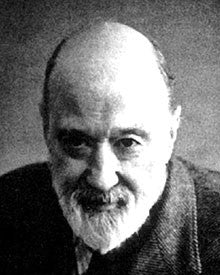
(1874 - 1954)
Born in Danbury, Connecticut on 20 October 1874, Charles Ives pursued what is perhaps one of the most extraordinary and paradoxical careers in American music history. Businessman by day and composer by night, Ives's vast output has gradually brought him recognition as the most original and significant American composer of the late 19th and early 20th centuries. A fascination with bi-tonal forms, polyrhythms, and quotation was nurtured by his father who Ives would later acknowledge as the primary creative influence on his musical style. Ironically, much of Ives's work would not be heard until his virtual retirement from music and business in 1930. Henry Cowell was perhaps the most significant figure in fostering public and critical attention for Ives's music, publishing several of the composer's works in his New Music Quarterly. In 1947, Ives was awarded the Pulitzer Prize for his Symphony No. 3, according him a much deserved modicum of international renown. Soon after, his works were taken up and championed by such leading conductors as Leonard Bernstein and, at his death in 1954, he had witnessed a rise from obscurity to a position of unsurpassed eminence among the world's leading performers and musical institutions.
Charles Ives Composition Timpani and Percussion Requirements
A Hampshire Suite
Timpani + 2 percussion
Anvil, clash cymbals, triangle, orchestral bass drum, snare drum, tambourine
__________________________________________________________________________________
A set of Three Pieces
Timpani + 3 percussion
Bass bells, Bb, Db, G, Ab, A nat, C4. C4 to F4 chromatic. Hi G, A, Bb
__________________________________________________________________________________
Central Park in the Dark
No Timpani + 2 percussion
Snare drum, orchestral bass drum with cymbals attached
__________________________________________________________________________________
Divertimento
Timpani + 1 percussion
Glockenspiel, tubular bells, xylophone, clash cymbals, triangle, orchestral bass drum, snare drum, tambourine
__________________________________________________________________________________
Fantasia
Timpani + 1 percussion
Xylophone, snare drum, clash cymbals, orchestral bass drum
__________________________________________________________________________________
From the Steeples to the Mountains
No Timpani + 4 percussion
1) bells C4-C5, 2) bells D2-Db3, 3) bells B3-B4, 4) bells C3-C4
__________________________________________________________________________________
Galop Joyeux
Timpani + 1 percussion
Glockenspiel, clash cymbals, triangle, orchestral bass drum, snare drum
__________________________________________________________________________________
Mam'zelle Angot
Timpani + 2 percussion
Glockenspiel, snare drum, triangle, xylophone, clash cymbals, orchestral bass drum, tambourine
__________________________________________________________________________________
Psalm 90
No Timpani + 4 percussion
1) high bells (A, G#, C), 2) Low bells (E, D, C, G, A), 3) Low bells ( C#, A, F), 4) low C gong, low C bell plate
__________________________________________________________________________________
Suite No.1 in Eb
Timpani + 2 percussion
Clash cymbals, triangle, orchestral bass drum, snare drum, tambourine
__________________________________________________________________________________
Symphony No 2
Timpani + 2 percussion
1) snare drum, 2) orchestral bass drum
__________________________________________________________________________________
Three Places in New England
Timpani + 2 percussion
Snare drum, orchestral bass drum with cymbals attached
__________________________________________________________________________________
Tuba Suite
No Timpani + 1 percussion
Glockenspiel, xylophone, triangle, snare drum, tambourine
__________________________________________________________________________________
William Byrd Suite
Timpani + 1 percussion
Glockenspiel, gong, tubular bells, clash cymbals, triangle, orchestral bass drum, snare drum
__________________________________________________________________________________
